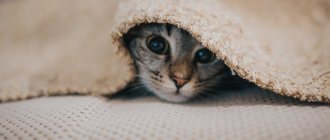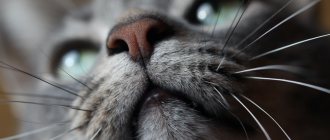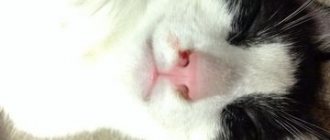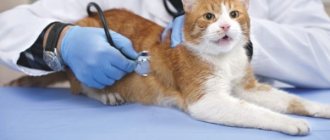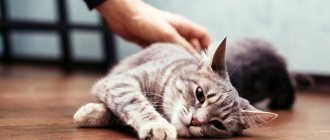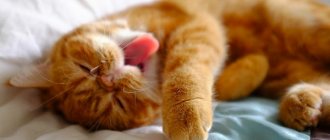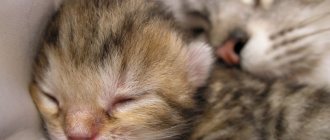Review of root causes
Before taking your pet to the veterinarian, you should make sure that the ulcer on the nose is not the result of an injury received in a fight or after a fall. If this point cannot be clarified (the owner was not present at the time of injury), then you need to keep in mind the following options associated with this symptom:
Eosinophilic granuloma. Mainly affects the oral mucosa, tongue, palate and lips. But it can also manifest itself as an ulcer on the nose, which practically does not bother the cat due to the lack of itching. Over the course of the process, its size may not change, but there is a risk of complications due to secondary infection. To confirm the diagnosis, a cytological examination of the fluid taken from the wound is performed. For small lesions, first try changing the brand of food, removing the plastic bowl and toys (if any). It is recommended to change the bowl to ceramics or glass. In most cases, this is enough, the ulcer heals within 1-2 weeks. If multiple lesions are present or the ulcer does not heal for a long time, then prednisolone can be used under the strict supervision of a doctor. But you need to understand that suppressing symptoms does not guarantee complete recovery. To do this, it is necessary to look for and exclude a possible cause (diet, flea dermatitis).
Wound. It can also cause ulcers on the nose of a cat at any age. Most often, such injuries occur after participating in fights with other animals. Deep scratches or abrasions become covered with a crust that itches. And if the pet constantly rips it off, then an ulcer forms at the site of the wound. Scratches and abrasions can be treated with an antiseptic solution (moisten a cotton swab with chlorhexidine and wipe thoroughly). If the sore is not complicated by a secondary infection, then complete healing occurs within 2-5 days.- Contact dermatitis. This is a common phenomenon among cats who like to stick their noses everywhere. Chemicals, detergents, and medications can act as irritating factors. A severe reaction may cause a large pink sore to appear on the nose. After such incidents, the animal is advised to take antihistamines. It is also necessary to prevent your pet from having access to potentially dangerous substances (powders, personal hygiene products, etc.).
Burn. It can also cause a red sore on a cat's nose. Most often found in kittens who are just exploring this world. Your pet can get burned on hot dishes or even food. In most cases, burns heal well and quickly. The wound becomes covered with a crust, which falls off on its own after 2-4 days. It is important to prevent the animal from tearing off the crust with its claws. Outdoor cats are more likely to experience frostbite, which is also accompanied by the appearance of sores on the face and limbs.- Parasites. Less common than the above circumstances, but can also cause the appearance of ulcers on a cat’s nose. Most often, this phenomenon can be caused by an allergic reaction to flea saliva. Therefore, to exclude this option, it is mandatory to treat the animal against fleas (Stronghold and Frontline are considered the most effective drugs today). Then worming is carried out (Drontal and Milbemax are considered the best today). And if after 3-4 weeks the symptoms persist, then the option of parasites is excluded.
- Neoplasms. Benign formations are more common in young animals, malignant ones are usually diagnosed after the age of 10 years. Benign neoplasms include papillomas that appear in different parts of the body. If they appear on the nose, then there is a risk that the pet may rip them off accidentally (during play or a fight) or on purpose (if they cause discomfort). In their place, an ulcer will form that will not heal for a long time. Therefore, papillomas located on the nose, eyelids, and lips are recommended to be removed. This is done using cryosurgery or laser.
In animals over the age of 10 years, when a nasal ulcer appears, the option of squamous cell carcinoma and carcinoma should be considered, to confirm which a puncture is taken from the lesion and sent for histological examination. Considering the location, treatment can only be medicinal. The prognosis at any stage of tumor detection is always cautious.
The crusts on your cat's nose may be brownish or black. This symptom is characteristic of a fungal infection, an inflammatory process in the nasopharynx, or an allergic reaction. The most harmless cause of crust formation is considered to be household injuries.
The fact is that a healthy cat's nose is slightly moist. This prevents the normal restoration of damaged skin, so wounds can take a long time to heal. If the owner is absolutely sure of the nature of the crusts, it is necessary to help the pet’s body recover as quickly as possible. To do this, it is recommended to treat your nose with an antiseptic several times a day. Preventing re-infection of the wound significantly accelerates regeneration and the crusts begin to disappear a few days after the start of treatment.
A dark crust on the nose, which is accompanied by discomfort and is a consequence of skin damage, should not be a cause for concern. In this case, no treatment is required; the crust will fall off on its own when the tissues are completely restored.
Skin diseases: causes, symptoms, treatment and prevention
There are so many skin diseases that affect cats that it is simply impossible to present all the available data about them in one article. However, there is a group of dermatological diseases that are most often diagnosed in these pets. It includes infections caused by various bacteria and fungi, pathologies caused by mites (demodex, otodectosis), lichen, psoriasis, acne, bedsores, allergies, bumps and other formations on the skin.
Bacterial infection
The most common cause of bacterial infections in felines is staph. This type of skin disease in pets can be recognized by a number of symptoms. Manifestations of the disease and its treatment depend on the form of the pathology. Information about how infections of bacterial origin occur in these animals and how they are treated is presented in the table:
Dry form of bacterial infection
| Forms of bacterial infection | Symptoms | Treatment methods |
| Dry | Dense formations and crusts on the skin. | To eliminate signs of infection, depending on the clinical picture, the four-legged patient is prescribed oral antibacterial drugs (Amoxiclav, Cefoxitin, Clindamycin, Cephalexin) and topical agents (Miramistin, Levomekol, zinc ointment). Also, medicated shampoos (Api-San, Elite) are indicated for a sick pet. |
| Wet | Hyperemia and moisture in the affected areas of the epidermis, accompanied by rashes, the formation of ulcers and weeping crusts, and itching. |
Fungal infections and different types of lichen
This type of skin disease, also known as “lichen,” is caused by fungi; less commonly, it occurs due to viruses, a nervous breakdown, hormonal imbalance, or allergies. Most often, the epidermis is affected by fungal infections Trichophyton Microsporum canis and Microsporum gypseum. If treatment is started in a timely manner, the animal can be cured in 21 days. If the deeper layers of the skin are affected, complete recovery may take up to 6 months. Information about the types of lichen (their photographs are posted below) in cats is presented in the table:
Ringworm
| Types of lichen in cats | Symptoms | Treatment |
| Shearer |
|
|
| Pityriasis (multi-colored) |
| |
| Pink (not fungal etiology) |
|
|
| Weeping (eczema, caused by hormonal imbalance, stress, etc.) |
|
|
Ear mite
Fungi can also infect the outside of your pet's ear. Most often, otomycosis is caused by Aspergillus or Candida. This disease is accompanied by severe itching, redness, slight discharge of purulent exudate, and greenish-gray or pure gray deposits.
Calcivirosis
If a black crust suddenly appears on your cat’s nose, you should take a close look at the animal’s behavior. One of the dangerous cat diseases is calcivirosis. Animals are usually vaccinated against this disease, but street cats that accidentally enter the house may not be vaccinated. Symptoms of calcivirosis:
- wounds and crusts on the mucous membranes of the mouth, ears and nose;
- conjunctivitis and tearing eyes;
- damage to the paw joints;
- increased body temperature;
- swollen lymph nodes;
- labored breathing.
To treat calcivirosis, you should consult your doctor about the use of medications. There is no universal treatment regimen for this disease; therapy is selected depending on the symptoms and age of the pet.
Crusts on the nose should be lubricated with chlorhexidine or Lugol's solution twice a day. To make breathing easier, the nasal passages must be treated with special drops.
If a cat has an ulcer on the nose, this may be a sign of pathologies such as infection with pathogenic microflora, an allergic reaction, polyps, or traumatic injuries. In addition to wounds, the condition may be accompanied by fever, sneezing, coughing, and changes in the animal’s behavior. At the first symptoms, it is recommended to take your pet to a veterinarian, who will prescribe medications or perform surgery.
According to statistics, timely treatment of calicivirus saves the lives of 80% of animals.
Treatment
A swollen cat's nose requires treatment, which will vary depending on what caused the condition.
We suggest you read: Food for Chow Chow dogs: how to choose and what to feed
Treatment of a cat is carried out in a veterinary clinic and depends on the cause of the tumor. Basic therapeutic measures for removing bumps on the cheek:
- Prescription of medications: antiseptics, antibiotics, anti-inflammatory ointments and gels, antihistamines, corticosteroids, NSAIDs.
- Applying a cold compress to the swollen area.
- Radiation and chemotherapy.
- Removal of pus, installation of a drainage tube.
If you do not immediately notice the lump, and the cat has a tumor on its cheek, you should immediately contact a veterinarian. An open wound can become infected, and the cat will not be able to eat or drink due to severe pain when opening its mouth.
Why do wounds occur?
Most often, the formation of ulcers and crusts on the nose is promoted by ailments, such as:
Calicivirus
When an animal is infected with such a virus, it may develop conjunctivitis.
It is caused by the Feline calicivirus virus. Infection occurs through contact with a sick animal through saliva, nasal moisture, tears, or when a healthy animal uses bowls and a tray of an infected animal. A cat can also inhale the virus. Manifestation:
- the appearance of wounds on the mucous membranes of the nose and mouth;
- refusal to eat;
- temperature increase;
- dyspnea;
- conjunctivitis;
- lameness due to inflammation of the joints.
Fungal infections
The causative agents are the fungi cryptococcosis, actinomycosis, and Candida. Routes of infection include contact with a sick animal, long-term use of antibiotics, and decreased immunity. Cats that come into contact with soil and birds can also become infected. The fungus can affect not only mucous membranes, but also appear on the pads of the paws, between the toes, and spread to the stomach and genitals. Symptoms:
- bloody discharge from the nose that forms crusts;
- cough, sneezing;
- temperature increase;
- the appearance of a whitish coating or scales on the respiratory system or in the mouth;
- general deterioration of condition.
Bordetellosis
This disease is characterized by the appearance of a cough in the pet.
The disease is caused by Bordetella bacteria, and the disease itself can be transmitted from animals to humans. Cats get sick through contact with saliva, moisture from the nose, sneezing of a bacteria carrier, and also by eating food from the bowl of a sick animal. Signs:
- discharge from the eyes and nose, at the site of which cracks and sores appear;
- decreased appetite;
- hyperemia;
- difficulty breathing;
- cough;
- enlarged lymph nodes.
Allergic reaction
It occurs as a response of the cat’s immune system to an allergen. These include cleaning products, indoor mold, dust, and medications. The cause of an allergic reaction can be food additives if the owner treats the pet with smoked or canned foods that are not intended for animals. Symptoms:
- crack or wound on the lips, nose, bald patches near the ears;
- redness of the ears and skin;
- hair loss, bald patches;
- severe itching of the affected areas;
- worry and anxiety.
Polypous formations
The presence of such formations in the nose forces the animal to shake its head frequently.
They are benign pedunculated growths that form on the nasal mucosa. They occur mainly against the background of chronic diseases of the nasopharynx - otitis media, rhinitis or due to impaired tissue development. Polyps can spread to the structures of the middle ear. Due to impaired nasal breathing, the cat rubs its nose, which causes a sore. In addition, the following signs indicate polyps:
- sniffling and wheezing;
- difficulty swallowing and breathing;
- change in voice timbre;
- frequent shaking of the head;
- impaired coordination of movements if the polyp has grown into the ear;
- weight loss due to difficulty eating because the nose is not breathing.
Bruises and wounds
Violation of the integrity of the nasal covering occurs as a result of a cat falling from a height, an accidental blow to a heavy object, or after a fight with relatives. Injuries provoke nosebleeds, so the damaged area becomes covered with a crust. The condition is manifested by the animal's restlessness, temporary aggression due to pain, snorting, and sneezing. However, bruises and wounds can be combined with serious head injuries. Therefore, you should consult a doctor if your cat develops the following symptoms:
The animal should be taken to the veterinarian if the injury is combined with a convulsive syndrome.
- impaired coordination of movements;
- vomit;
- nosebleeds that won't stop;
- convulsions;
- loss of consciousness.
Non-communicable causes
There are the following types of non-infectious diseases in which crusts form on the nose:
- allergic conditions;
- injuries;
- violation of conditions of detention.
Allergic conditions
All allergens that cause a runny nose lead to the release of exudate, which dries out and crusts form. The nasal mirror is injured by hard scabs, ichor is released, secondary microflora is added and the pet’s condition worsens.
The development of a hypersensitive reaction is influenced by the following unfavorable factors:
- increased sensitivity to feed mixture ingredients;
- response to pollen from flowering plants;
- irritating effects of perfume odors, tobacco smoke, household chemicals;
- irritating effects of toys, tray filler, bedding made of synthetic materials;
- reaction to human hair or the fur of other pets;
- side effects of medications.
Treatment consists of eliminating the causes. Caused an inappropriate reaction. They stop taking medications that can cause an allergic response and switch to ready-made hypoallergenic food.
Remove objects that emit odors from the room and stop smoking in the presence of the pet. Change the tray filler and bedding. In some situations, the use of antihistamines is required.
Injuries
Such crusts heal on their own
. Crusts are formed if a cat scratches its nose in a fight or through contact with sharp or prickly objects. When you hit the nose, slight bleeding may occur; the released liquid dries, forming crusts. If there is no suppuration under the scabs, observe the healing process of skin defects. Otherwise, use an antiseptic wound-healing ointment.
Be sure to read:
The cat doesn’t eat, only drinks water, is lethargic: reasons for what to do if he refuses to eat and sleeps
Violation of containment conditions.
When the central heating is turned on in winter or during hot weather, the air dries out and the skin on the cat's nose cracks. The ichor is released, which dries and forms crusts. If in hot weather the cat is exposed to a stream of cold air from an air conditioner, hypothermia develops and rhinitis occurs, in which snot is released from the nose. They dry out and form crusts.
Frequent bathing in combination with drafts in the apartment also leads to hypothermia and rhinitis. Treatment consists of introducing immunomodulatory or antimicrobial drops into the nasal cavity.
How to treat ulcers on the nose?
Surgical intervention
Surgery is required for polypous growths. A ventral Bull osteotomy is performed, in which the lower part of the middle ear bone is excised and the polyp is removed. The polyp is also pulled out, causing it to tear away from the stalk. However, this method is dangerous for the development of relapses.
Drug therapy
Liniments should be applied to the nose while the cat is sleeping, otherwise she will lick the medicine, which will cause bowel upset.
All medications are prescribed by a veterinarian; self-medication is unacceptable. Minor scratches on the nose heal on their own. If suppuration occurs, it is recommended to lubricate the organ with Levomekol liniment. It is recommended to treat the crusts with a decoction of chamomile, calendula, and oak bark. For infectious diseases, depending on the etiology, the drugs shown in the table are prescribed:
| Drug group | Medication |
| Antibiotics | "Enroxil" |
| "Clavaseptin" | |
| Bayer Baytril | |
| "Zoetis Synulox" | |
| "Veraflox" | |
| Antifungal | "Ketoconazole" |
| "Clotrimazole" | |
| Potassium iodide | |
| Saline solutions | Sodium chloride |
| "Ringera" | |
| Glucose | |
| Immunostimulants | Any vitamin and mineral complexes for cats |
| "Gamavit" | |
| Antibacterial lotions for treating sores on the nose | "Divopride" |
Tip 1: Causes of crusts on the nose of cats
Why a cat sneezes can only be understood by carefully observing its appearance, well-being and behavior. The reason may simply be dust under the cabinet that accidentally got into the pet’s respiratory tract. But if sneezing is repeated, this may be one of the symptoms of an incipient disease. First, it is necessary to exclude the presence of parasites, which in some cases is accompanied by sneezing. Therefore, it is advisable for the owner to urgently give his pet anti-helminth medications. They are sold in every veterinary pharmacy specifically for cats and are used depending on the weight of the animal. They are mixed with a small amount of food and given to the pet. At the same time, all family members must also take antihelminthic drugs for people. After this procedure, cats should put special drops between their shoulder blades against fleas. Flea secretions can cause allergies, including sneezing. If, after introducing a new food or immediately after purchasing a chair, your pet begins to sneeze frequently, but no other symptoms are observed, this may be a consequence of an allergy. It is advisable to analyze what has happened new in the cat’s life in the last week, and when exactly he began to show alarming signs. Sometimes it is enough to simply exclude the allergen. If these measures have not helped at all, and the cat continues to sneeze, there is no need to try to find answers on veterinary forums. After all, from such advice “blindly” you can lose precious time necessary for effective treatment of the animal. The rule of harm of self-medication also applies here. The danger can threaten not only the pet itself, but also other pets, and even the owners themselves. For example, feline toxoplasmosis, as well as chlamydia, are a serious threat of miscarriage in pregnant women. Sometimes sneezing in cats is accompanied by lacrimation and runny discharge from the nose. At the same time, the animal’s appetite worsens and lethargy appears. Such signs may be present both with the feline herpes virus and with many diseases of the upper respiratory tract caused by fungi, bacteria and viruses: toxoplasmosis, chlamydia, bordetellosis, rhinotracheitis, calicivirus, etc. If, after curing the parasites and eliminating the possibility of allergies in the animal, The cat's sneezing continues, you should contact your veterinarian so that he can correctly diagnose the animal and prescribe effective treatment. Next, the task of pet owners is to carry out all the necessary procedures on time, be it nasal drops, injections or medicine in tablets. So, you should carefully observe all personal hygiene measures and limit the interaction of a sick animal with household members. And the owner serving the cat must wear a protective mask and gloves. In any case, the disease is easier to prevent than to treat. For this purpose, special vaccines are used. It is best to start vaccinating young kittens at six weeks of age. Until the age of fifteen weeks, babies are given several vaccinations at intervals of 3–7 weeks: against leukemia, rabies, cat flu and panleukopenia. Also, do not forget about good animal nutrition and hygiene.
Useful materials:
Stages of mammary gland cancer in cats Like in humans, mammary gland cancer in cats has ...
Feeding your furry companion, playing with him, and cleaning the litter box is an easy task. To keep your cat healthy, you need to know what these animals suffer from and how you can help them.
Nose injuries
The nasal planum is an organ that provides the domestic predator with a significant amount of information about the surrounding world. When getting acquainted with something new, a cat carefully sniffs the object. She does the same with new pets or guests. By touching the owner’s hands and shoes and his things with his nose, the animal “reads information” about where the person has been, with whom he has been in contact, and what he has touched.
By sniffing food, the little hunter determines not only its freshness and edibility, but also its temperature. Injuries to the nasal planum are possible both in a pet that is allowed outside and in a couch potato.
A sore on a cat’s nose can appear after a fight with relatives, an unsuccessful jump from a height, or sniffing thorny indoor plants. Pets that live in the same house from a young age often do not perceive each other as links in the food chain. They play, communicate with each other, and not always neatly.
In case of a minor injury or ulcer on the nose, the cat can be treated by lubricating the nasal planum with vegetable oil, such as sea buckthorn or olive. A little tea tree essential oil is first added to olive oil (2-3 drops per 1 tsp), which improves wound healing and helps suppress the activity of microorganisms (bacteria, viruses, fungi). Before the procedure, you can lightly wash the wound by touching it with a cotton pad soaked in a pale pink solution of potassium permanganate (potassium permanganate).
If there is no effect from home treatment within 3-5 days, a veterinarian will help cure the small predator. Perhaps an infection has joined the injury or there is an allergic reaction to something.
Sores on the nose and lips
#1 Kotolyushka
- Regular visitors
- 811 messages
- Moderators
- 11,803 messages
- Moderators
- 10,792 messages
- Participants++
- 5,310 messages
- Participants++
- 5,310 messages
- Regular visitors
- 811 messages
- Photo014.jpg 158.3K 703 Number of downloads:
Women and cats always do as they please. Men and dogs can only relax and come to terms with this state of affairs.
(R. Heinlein)
I don’t know who I was in a past life, I don’t even know who I am in this life, but in the next I’ll be a cat! Then I’ll tell people what I think of them!!
A castrated cat is a full-fledged cat in every sense, except: he doesn’t yell, doesn’t leave smelly marks, doesn’t run away on a spree, doesn’t come tattered and wounded, he won’t give rise to kittens that no one wants!
#4 Delphinium
Honorary Sonya of the Forum
She had no trace of bloody wounds. Just black scabs, no wounds.
#5 Delphinium
Honorary Sonya of the Forum
#6 Kotolyushka
Attached files
Women and cats always do as they please. Men and dogs can only relax and come to terms with this state of affairs.
(R. Heinlein)
#7 Delphinium
Honorary Sonya of the Forum
#8 Delphinium
Honorary Sonya of the Forum
I don’t know who I was in a past life, I don’t even know who I am in this life, but in the next I’ll be a cat! Then I’ll tell people what I think of them!!
A castrated cat is a full-fledged cat in every sense, except: he doesn’t yell, doesn’t leave smelly marks, doesn’t run away on a spree, doesn’t come tattered and wounded, he won’t give rise to kittens that no one wants!
#10 Delphinium
Honorary Sonya of the Forum
#11 Kotolyushka
We recommend reading: Antibiotics for false pregnancy in a cat
Girls, we were without the Internet for two days. In general, this is the situation we have today. We consulted with the vet. The first hypothesis is an allergy, presumably to food. They gave me an antihistamine, washed the sores with furatsilin and smeared them with tea tree. But something doesn't help very much. In some places the sores have healed, but under the fang on one side there is a rather large wound and it seems to be purulent. It’s difficult to examine anything, because there’s a large blood clot there that can’t be soaked out yet—it doesn’t allow it. Nafanya, on the one hand, doesn’t seem to mind eating, but on the other hand, she eats very little. He eats a spoonful of sour cream, then fresh blood begins to leak from the sores. Veto called again today. Now the second guess is a viral infection. Maybe even from Malyavka (although she shows no signs). He told me to take the temperature, but the first attempt failed. Nafa’s mouth can hardly handle it, let alone the temperature. I'm waiting for him to calm down, then we'll try again. The main thing is that I can’t say that he is very sluggish. Just the day before yesterday - yes. And today he met me and runs into the kitchen. He just doesn't eat. We have been prescribed cycloferon for now, I’ll go buy it tomorrow. I just can’t imagine how to inject it. But let's think
Women and cats always do as they please. Men and dogs can only relax and come to terms with this state of affairs.
(R. Heinlein)
#12 VirtKat
Oh, poor boy, was he vaccinated or not?
#13 Kotolyushka
Women and cats always do as they please. Men and dogs can only relax and come to terms with this state of affairs.
(R. Heinlein)
#14 VirtKat
Olya, isn’t it too much to smear tea tree on open wounds, even though you dilute it, maybe it’s easier with peroxide or chlorhexidine (it won’t sting and smell on the cat)? I will again advocate for mumiyo until we figure out what it is. Did you take any microflora cultures from these sores from Nafa?
Take a look at some veterinary forum, maybe they’ll give you better advice!
I don’t know who I was in a past life, I don’t even know who I am in this life, but in the next I’ll be a cat! Then I’ll tell people what I think of them!!
A castrated cat is a full-fledged cat in every sense, except: he doesn’t yell, doesn’t leave smelly marks, doesn’t run away on a spree, doesn’t come tattered and wounded, he won’t give rise to kittens that no one wants!
#16 Delphinium
Honorary Sonya of the Forum
#17 Kotolyushka
Women and cats always do as they please. Men and dogs can only relax and come to terms with this state of affairs.
(R. Heinlein)
I don’t know who I was in a past life, I don’t even know who I am in this life, but in the next I’ll be a cat! Then I’ll tell people what I think of them!!
A castrated cat is a full-fledged cat in every sense, except: he doesn’t yell, doesn’t leave smelly marks, doesn’t run away on a spree, doesn’t come tattered and wounded, he won’t give rise to kittens that no one wants!
#19 Delphinium
Honorary Sonya of the Forum
Girls, we were without the Internet for two days. In general, this is the situation we have today. We consulted with the vet. The first hypothesis is an allergy, presumably to food. They gave me an antihistamine, washed the sores with furatsilin and smeared them with tea tree. But something doesn't help very much. In some places the sores have healed, but under the fang on one side there is a rather large wound and it seems to be purulent. It’s difficult to examine anything, because there’s a large blood clot there that can’t be soaked out yet—it doesn’t allow it. Nafanya, on the one hand, doesn’t seem to mind eating, but on the other hand, she eats very little. He eats a spoonful of sour cream, then fresh blood begins to leak from the sores. Veto called again today. Now the second guess is a viral infection. Maybe even from Malyavka (although she shows no signs). He told me to take the temperature, but the first attempt failed. Nafa’s mouth can hardly handle it, let alone the temperature. I'm waiting for him to calm down, then we'll try again. The main thing is that I can’t say that he is very sluggish. Just the day before yesterday - yes. And today he met me and runs into the kitchen. He just doesn't eat. We have been prescribed cycloferon for now, I’ll go buy it tomorrow. I just can’t imagine how to inject it. But let's think
Infectious diseases
Cats are susceptible to viral infections:
- Calcivirosis. The causative agent is feline calicivirus. Can affect joints and the central nervous system.
- Rhinotracheitis. Caused by feline rhinotracheitis herpesvirus. May lead to miscarriage.
- Reovirosis. Caused by a reovirus transmitted through the bites of blood-sucking insects. Often accompanied by diarrhea.
The human body is immune to these pathogens. Pets become infected through contact with sick individuals or apparently healthy virus carriers, as well as their secretions. People bring infection into the house on shoes, clothes, household items, etc.
Symptoms of viral diseases:
- hyperthermia;
- lethargy, weakness, lack of interest in favorite activities (games, communication);
- decreased appetite or refusal to eat;
- discharge from the eyes and nose, drooling;
- hyperemia and ulceration of the mucous membranes of the lips, oral cavity, gums, tongue, back wall of the pharynx;
- cough, sneezing.
Dermatological diseases
The cat's body is susceptible to autoimmune diseases. In such cases, the immune system attacks the body's own tissues where the target cells are located. Dermatoses of this type include:
- Pemphigus foliaceus. The intercellular epidermal tissue is affected, which leads to the appearance of pustular rashes on the face. May be accompanied by hyperthermia, lethargy, and refusal to eat. A biopsy of the affected areas is necessary.
- Common pemphigus. The epidermis stratifies with the formation of bubbles filled with liquid, which burst, turning into ulcers on the nose, lips and in the oral cavity. May be fatal. A histological examination of the damaged mucosa is required.
- Erythematous pemphigus. Most often, only the nose is affected. Accompanied by pigmentation disorders, rashes, ulceration of the nasal planum, bridge of the nose and bridge of the nose, and the formation of scabs.
- Pemphigus vegetans. A relatively mild form of dermatosis. Main symptoms: rash and blisters.
- Systemic lupus erythematosus. Skin manifestations are observed in the discoid form, involving the nose, ears, eyelids, lips. The process begins with changes in pigmentation and redness, then ulcers form. Systemic disorders include: damage to the hematopoietic system (anemia, decreased blood clotting), kidneys, joints, gastrointestinal tract, central nervous system. Tests for antinuclear antibodies and a biopsy of the epidermis are necessary.
- Vasculitis. The disease affects blood vessels, which leads to a deterioration in the blood supply to tissues and their subsequent death. Most often, the nose, lips, tip of the tail, ears, paw pads, and genitals are affected.
- Cold agglutinin disease. Reason: at low ambient temperatures, red blood cells interact with immunoglobulins. The same areas are damaged as with vasculitis. They acquire a bluish coloration, pigmentation is disrupted, and hair falls out. In severe cases, necrosis may occur.
If these symptoms appear, you should contact your veterinarian as soon as possible. He will prescribe the necessary tests, conduct an examination and make a diagnosis. Treatment of autoimmune diseases is a complex and lengthy process, including therapy with corticosteroids and immunosuppressants.
Skin diseases
The presence of diseases can also affect the condition of the cat's fur and its loss. Let's list the ones that often occur and cause severe loss.
- Skin mites
. A skin lesion that is very unpleasant for an animal, causing discomfort with severe itching, rashes, and inflammatory phenomena that appear in areas of the skin affected by mites. You can recognize the disease by the first symptoms, which appear in the form of dull fur and bald spots on the face, ears and front legs. - Fungal diseases
(ringworm, mycosis). Having discovered the first signs of such lesions, you cannot take any measures on your own; immediately contact a veterinary clinic. We must remember that they are very dangerous for people. A sign of a fungal disease is that the hair falls out in round bald spots, which then form entire lesions. Inside them, scaly formations on the skin are noticeable. After diagnosis, the veterinarian will prescribe treatment, which must be strictly followed. - Flea dermatitis
. Flea saliva can cause an allergic reaction in cats. In addition to extensive hair loss, it can lead to severe redness and itching of the skin. With this disease, most often cats may lose hair on their back. - Allergic dermatitis
. Cats can react to irritants such as household chemicals, pollen, dust, etc. All these substances can cause quite severe allergies, which, in addition to hair loss, causes discomfort to the pet in the form of itching, redness of the skin, and the cat develops sores in areas where it is scratched. - Psychological reaction to external factors
. The sensitivity of cats to external stimuli is not new. Any phenomenon that causes stress in an animal can make the cat not only timid and even aggressive, but also encourage him to pull out his fur with his teeth in those areas where he can reach. This includes the stomach, the back, and the paws. At the same time, bleeding wounds and ulcers appear on bald skin, which can become a gateway for various infections. - Seborrhea
. This skin disease is characterized by particularly severe hair loss on any part of the body. The skin becomes inflamed, oily, and foul-smelling.
Only a competent veterinarian can determine the exact reason why a cat’s hair is falling out, because the same symptoms can be a manifestation of various diseases. To make a diagnosis, you will need to undergo a series of examinations and tests. Based on the diagnosis, the doctor will prescribe treatment that will help restore the pet’s skin and coat.
Crusts on a cat's nose
The cause of sores and crusts on the nose in cats can be malignant neoplasms. Most often, this is squamous cell carcinoma that occurs on the skin and mucous membranes in the head area. The cause of the disease is excessive exposure to the sun. It is more common in areas with a warm climate and plenty of sunny days.
The risk group includes individuals who are white or have large white spots on their bodies. The likelihood of malignant degeneration increases as the animal ages and with increasing time spent outside the home during hours of active UV radiation (from 10-11 a.m. to 4-5 p.m.).
- long-term non-healing erosions on the skin;
- dark red spots with a cauliflower-like surface;
- crusty, concave ulcerations surrounded by an edematous ridge.
When cancerous lesions become infected with bacteria or fungi, a film or plaque with an unpleasant odor appears on them.
If the sore does not heal within 10-15 days, and progression of symptoms is observed (expansion of the affected area, enlargement of lymph nodes, deterioration in the pet’s general well-being), you should consult a veterinarian. In the absence of adequate therapy, squamous cell carcinoma gradually not only destroys the nasal cavity, but also spreads to neighboring areas. As a result, the animal may die.
The diagnosis of the disease is carried out by a specialist. He prescribes a biopsy of the affected area and blood tests. If necessary, an MRI is performed and an X-ray is taken. Timely diagnosed squamous cell carcinoma responds well to treatment: the affected areas are surgically removed. If the tumor is small, it is subjected to laser ablation.
Skin and other diseases
The appearance of crusts on the nose often accompanies fungal and bacterial skin lesions. If you suspect a bacterial infection, you should show the cat to the doctor so that the veterinarian can examine it - make a scraping, conduct a diagnosis using an ultraviolet lamp. Other signs of skin diseases are cracks on the paw pads, ulcerations on the skin, and areas of split ends and hair falling out.
We should not forget that many skin infections of cats are also dangerous for humans, so try to exclude contacts of younger family members with a sick cat and follow the rules of hygiene.
Sometimes the appearance of crusts on the nose can be caused by allergies: it can be dried discharge from allergic rhinitis or skin irritation.
Wounds and allergies
The cause of sores on the nose may be an allergic reaction. Incorrectly selected food, various medications, vitamins, and indoor plants can lead to allergies, accompanied by rashes and itching. The cat licks the itchy area of the nasal planum with its hard, rough tongue, tearing off the thin and delicate top layer of skin. It is necessary to find the allergen and remove it from the apartment. If this is a drug, you should consult your veterinarian about replacing it. A specialist may prescribe antihistamines.
Liver and kidney diseases
Seemingly “harmless” sores on the nose can indicate dangerous pathologies of the liver and kidneys. In particular, such symptoms are quite typical for renal and liver failure; they often appear with urolithiasis or cholecystitis. You can guess this if there are specific clinical signs:
- Change in the color of stool, which may become faded or overly colored.
- The animal's appetite disappears or becomes severely impaired.
- In severely advanced cases of kidney disease, an unpleasant and strong “chemical” odor, or the smell of ammonia, may emanate from the animal. In case of liver diseases, a cat’s mouth often smells of acetone.
- With liver diseases, all visible mucous membranes may turn yellow, including those in the eyes, mouth and nose.
First aid in such cases will never replace an urgent visit to the clinic! The owner can do the following:
- Feed (after consultation with a specialist) should be used specially intended for animals with liver/kidney diseases.
- Since the sores in these cases form “for a long time and seriously,” it is necessary to treat them three times a day with 1% hydrogen peroxide and lubricate them with syntomycin liniment.
- The pet needs to be given more fluids so that the toxins that contribute to the formation of ulcers on the skin of the nose are quickly eliminated from the body.
Calcivirosis
Calcivirosis is a dangerous viral disease of cats. In addition to the nose and oral cavity, the infection can affect the respiratory, hematopoietic and nervous systems of animals, and the digestive organs. The disease is often severe, with symptoms appearing within 1-3 weeks, and about a third of those affected die. Survivors are able to shed the virus into the environment for up to 12 months. With stress, deterioration of living conditions, infection with VLK or FIV, a relapse of calicivirus occurs. If a secondary infection occurs, the mortality rate increases to 80%.
To avoid death, you need to show the animal to a veterinarian as soon as possible.
Disease Prevention
Prevention of cat diseases includes:
- Rational, balanced nutrition. Lack of vitamins, microelements and nutrients necessary for the animal weakens the body.
- If it is not planned for cats to continue breeding, but to be kept only as a pet, sterilization (castration) is recommended. Sexual arousal negatively affects the health of animals, leading to congestion in the genitourinary system, fights and injuries.
- White individuals should not be allowed outside all day in the summer.
- Animals that participate in exhibitions or are kept free-range are recommended to be vaccinated. You must first make sure that your pet is healthy and not a virus carrier.


